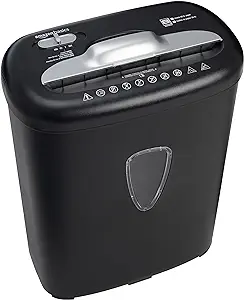
Document shredders are essential office tools designed to destroy sensitive and confidential documents, ensuring data privacy and security. Here are the key features and descriptions of document shredders.
Key Features of Document Shredders:
- Shred Types:
- Strip-Cut: Cuts documents into long, vertical strips. Offers basic security but is less secure than other types.
- Cross-Cut: Slices documents into small rectangular pieces, providing a higher level of security.
- Micro-Cut: Reduces documents to tiny confetti-like pieces, offering the highest level of security, suitable for highly sensitive documents.
- Shredding Capacity:
- Sheet Capacity: The number of sheets a shredder can handle at once, typically ranging from 5 to 20 sheets per pass.
- Speed: Measured in feet per minute (FPM), indicating how quickly the shredder can process documents.
- Bin Capacity:
- Waste Bin Size: The volume of the bin that collects shredded material, usually measured in gallons. Larger bins require less frequent emptying.
- Bin Full Indicator: Alerts users when the bin needs to be emptied.
- Run Time and Duty Cycle:
- Continuous vs. Limited Run Time: Some shredders can operate continuously, while others require cooling periods after a certain amount of time (e.g., 5 minutes on, 30 minutes off).
- Duty Cycle: The duration a shredder can operate before needing a cool-down period.
- Security Level:
- DIN Security Levels: European standards (DIN 66399) range from P-1 to P-7, with higher numbers indicating smaller particle sizes and greater security. P-3 and P-4 are common for general office use, while P-5 to P-7 are used for highly confidential information.
- Safety Features:
- Jam Protection: Anti-jam features, such as auto-reverse, to prevent and clear paper jams.
- Safety Sensors: Sensors that detect hands or objects near the feed opening and stop the shredder to prevent accidents.
- Thermal Protection: Prevents overheating by automatically shutting down the shredder if it becomes too hot.
- Additional Features:
- Quiet Operation: Designed to operate with minimal noise, ideal for shared office spaces.
- Credit Card and CD Shredding: Some models can also shred credit cards, CDs, and DVDs.
- Auto-Feed: Allows users to load a stack of papers for automatic shredding without manual feeding.
Description:
Document shredders are vital for maintaining data privacy and protecting sensitive information from unauthorized access. They come in various types and sizes to meet different security needs and office environments.
Types of Document Shredders:
- Personal Shredders:
- Description: Compact and designed for individual use at home or a small office.
- Features: Typically strip-cut or cross-cut, with a small bin capacity and lower sheet capacity.
- Use Case: Suitable for disposing of personal documents, such as bank statements and bills.
- Office Shredders:
- Description: Larger and more robust, designed for shared use in a small to medium-sized office.
- Features: Cross-cut or micro-cut, higher sheet capacity, and larger bin capacity.
- Use Case: Ideal for regular shredding of office documents containing confidential information.
- Commercial Shredders:
- Description: High-capacity and heavy-duty, designed for continuous use in large offices or institutions.
- Features: High sheet capacity, large bin, continuous run time, and advanced security features.
- Use Case: Suitable for environments where large volumes of sensitive documents are regularly shredded.
By understanding these features and categories, you can select the right document shredder for your specific needs, ensuring the secure and efficient disposal of sensitive information.







